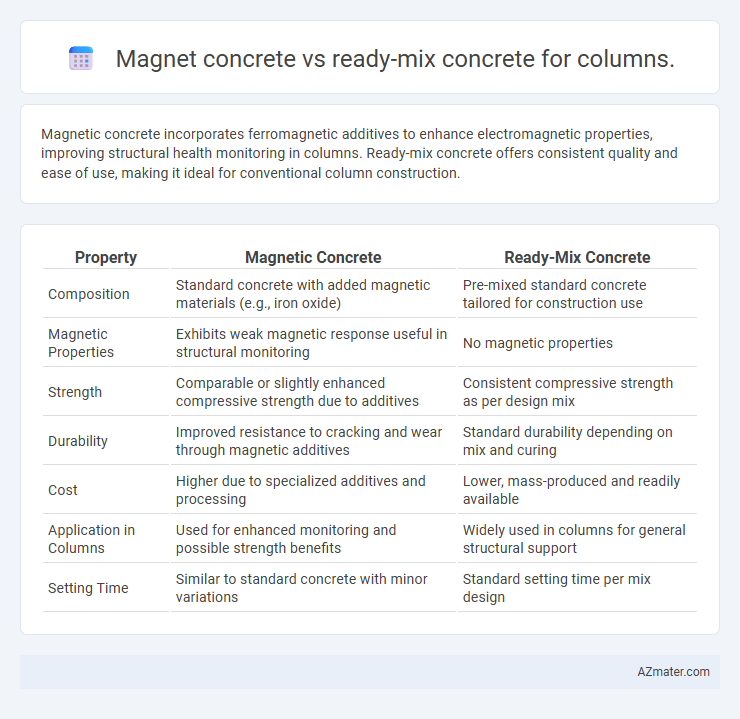Magnetic concrete incorporates ferromagnetic additives to enhance electromagnetic properties, improving structural health monitoring in columns. Ready-mix concrete offers consistent quality and ease of use, making it ideal for conventional column construction.
Table of Comparison
| Property | Magnetic Concrete | Ready-Mix Concrete |
|---|---|---|
| Composition | Standard concrete with added magnetic materials (e.g., iron oxide) | Pre-mixed standard concrete tailored for construction use |
| Magnetic Properties | Exhibits weak magnetic response useful in structural monitoring | No magnetic properties |
| Strength | Comparable or slightly enhanced compressive strength due to additives | Consistent compressive strength as per design mix |
| Durability | Improved resistance to cracking and wear through magnetic additives | Standard durability depending on mix and curing |
| Cost | Higher due to specialized additives and processing | Lower, mass-produced and readily available |
| Application in Columns | Used for enhanced monitoring and possible strength benefits | Widely used in columns for general structural support |
| Setting Time | Similar to standard concrete with minor variations | Standard setting time per mix design |
Introduction to Magnetic Concrete and Ready-Mix Concrete
Magnetic concrete integrates ferromagnetic materials into traditional cement mixtures, enhancing structural properties like strength and durability, while offering electromagnetic shielding benefits. Ready-mix concrete is a pre-mixed, factory-prepared blend of cement, aggregates, water, and admixtures tailored for immediate use, ensuring consistent quality and minimizing on-site labor. Both materials serve specialized roles in column construction, with magnetic concrete targeting enhanced performance parameters and ready-mix concrete prioritizing convenience and uniformity.
Composition Differences: Magnetic Concrete vs Ready-Mix
Magnetic concrete incorporates magnetic nanoparticles such as magnetite or iron oxide within its cement matrix, enhancing thermal conductivity and magnetic properties, unlike ready-mix concrete which primarily consists of cement, aggregates, water, and admixtures standardized for general use. The inclusion of ferromagnetic materials in magnetic concrete alters its microstructure, providing improved alignment of particles and potential electromagnetic shielding capabilities. Ready-mix concrete relies on precise batching and mixing control for uniform strength and workability but lacks the specialized magnetic components that define magnetic concrete's functional advantages in specific engineering applications.
Material Properties and Performance in Columns
Magnetic concrete incorporates ferromagnetic materials, enhancing load-bearing capacity and crack resistance in columns compared to traditional ready-mix concrete. Its improved magnetic permeability contributes to better internal stress distribution, resulting in increased durability and structural integrity under cyclic loads. Ready-mix concrete, while widely used for uniformity and convenience, typically exhibits lower tensile strength and less resistance to environmental degradation in critical column applications.
Structural Strength Comparison
Magnetic concrete incorporates ferromagnetic materials that enhance the internal microstructure, resulting in higher compressive and tensile strength compared to traditional ready-mix concrete. Studies show magnetic concrete can increase load-bearing capacity by up to 20%, improving the durability and stability of structural columns under dynamic and static loads. Ready-mix concrete offers consistent quality and faster application but lacks the magnetic properties that contribute to the improved structural integrity seen in magnetic concrete columns.
Durability and Longevity Factors
Magnetic concrete enhances durability by incorporating magnetic nanoparticles that improve resistance to cracking and corrosion compared to traditional ready-mix concrete, making it ideal for columns exposed to harsh environments. The presence of magnetite particles in magnetic concrete contributes to a denser microstructure, reducing permeability and extending the service life of structural columns. In contrast, ready-mix concrete's longevity depends heavily on mix design and curing conditions, which may result in variable durability under aggressive conditions.
Installation and Construction Processes
Magnetic concrete incorporates ferromagnetic materials that enable electromagnetic curing, accelerating the hardening process compared to ready-mix concrete, which relies on traditional hydration methods. Installation of magnetic concrete requires specialized equipment to generate magnetic fields during setting, potentially reducing curing time and improving early strength development. Ready-mix concrete benefits from standardized mixing and delivery processes, allowing straightforward on-site pouring and finishing but demands longer curing periods without electromagnetic assistance.
Cost Analysis and Economic Considerations
Magnetic concrete generally incurs higher initial costs due to the incorporation of ferromagnetic materials and specialized mixing processes, making it less economically feasible for large-scale column construction compared to ready-mix concrete. Ready-mix concrete offers cost advantages through mass production efficiencies, lower material expenses, and reduced labor requirements, which significantly lower the overall project budget. Economic considerations favor ready-mix concrete for typical column applications, while magnetic concrete's benefits may justify its price only in niche projects requiring enhanced electromagnetic properties.
Environmental Impact and Sustainability
Magnetic concrete incorporates ferrous materials that enable electromagnetic properties while potentially reducing cement content, which decreases CO2 emissions compared to traditional ready-mix concrete. Ready-mix concrete, widely used for columns, relies on high Portland cement proportions, contributing significantly to carbon footprints and resource depletion. Utilizing magnetic concrete can enhance sustainability by lowering environmental impact through reduced raw material usage and enabling potential recycling of magnetic components.
Suitability for Different Column Applications
Magnetic concrete, enhanced with ferromagnetic materials, offers superior electromagnetic shielding and is ideal for specialized columns in industrial or research facilities requiring electromagnetic interference control. Ready-mix concrete provides consistent strength, workability, and rapid setting times, making it suitable for standard structural columns in residential, commercial, and infrastructure projects. The choice depends on the specific application requirements such as load-bearing capacity, environmental conditions, and electromagnetic properties needed for the column design.
Future Prospects and Innovations in Concrete Technology
Magnetic concrete, leveraging embedded magnetic materials for self-sensing and structural health monitoring, offers promising advancements compared to traditional ready-mix concrete, which remains widely used for its uniformity and ease of application in columns. Future prospects include integrating nanotechnology and smart sensors within magnetic concrete to enhance durability, crack detection, and load management, potentially revolutionizing structural engineering. Innovations in self-healing magnetic composites and energy-harvesting capabilities could significantly improve the lifespan and performance of concrete columns in infrastructure projects.

Infographic: Magnetic concrete vs Ready-mix concrete for Column
 azmater.com
azmater.com